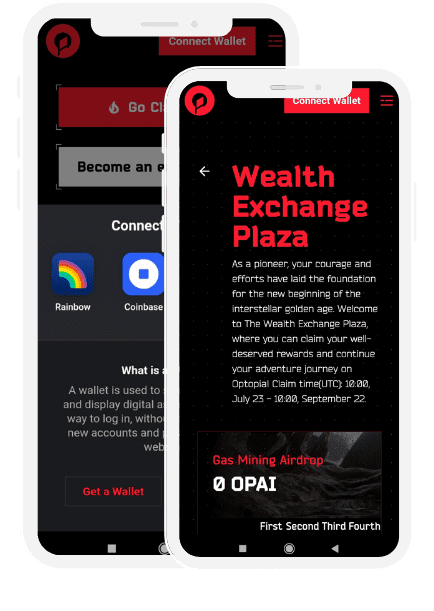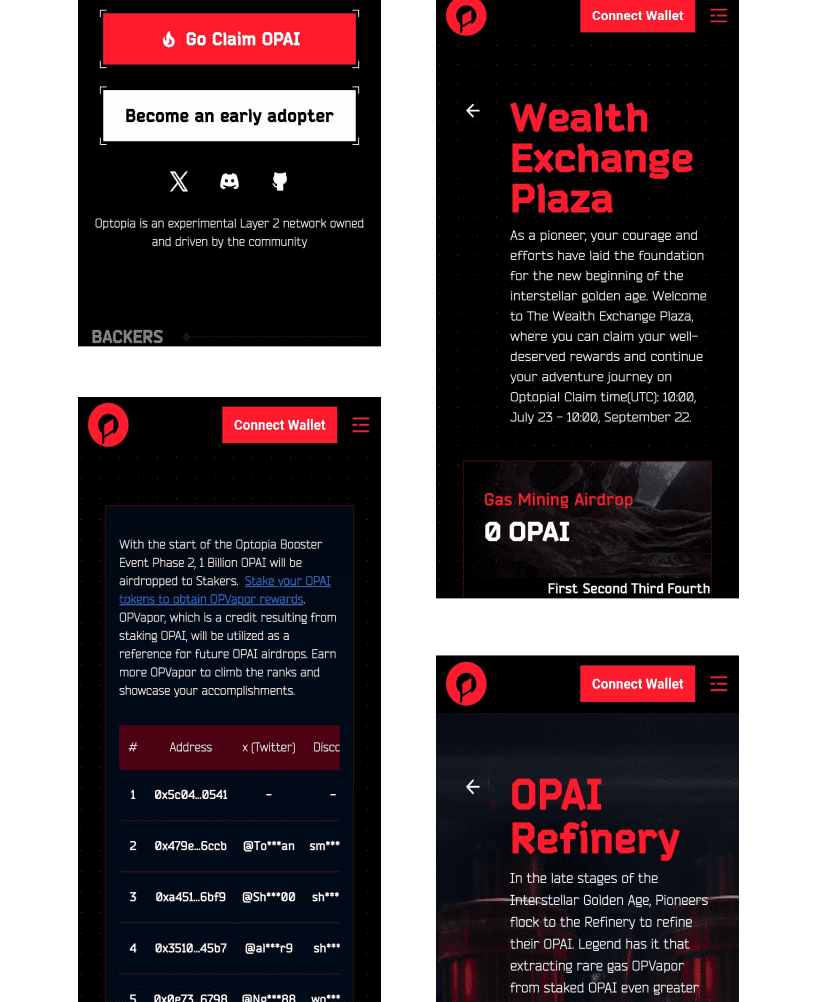Hybrid Consensus unites PoS and PoW, balancing security, speed, and decentralization. It delivers faster blocks, strong resilience, and scalability, ensuring optimal blockchain performance for diverse applications and sustainable growth.

Optopia is a next-generation Layer 2 blockchain network that integrates artificial intelligence with a decentralized, community-centric design to transform DeFi and Web3 Applications. Built as a permissionless ecosystem, Optopia allows users to create, manage, and execute decentralized operations using an AI-driven, intent-based approach that enhances security, transparency, and user autonomy.

The client envisioned Optopia as an advanced blockchain platform that emphasizes user intent and community participation. A central requirement was permissionless intent creation, enabling users to freely create and execute actions without the need for centralized control. The platform needed to provide a user-friendly ecosystem supporting activities like staking, airdrops, and leaderboard tracking, accessible to both new and experienced users. Additionally, a developer-friendly environment with extensive tools and resources for efficient Layer 2 dApp Development was essential to encourage innovation.
Optopia’s design also called for the secure integration of AI, allowing intent-driven actions to align with Layer 2 functionalities, enhancing the ecosystem’s capabilities. A focus on interoperability was key, enabling users to bridge assets across blockchain networks seamlessly. Transparent governance and a well-defined consensus structure were essential to ensure community members had a voice in the platform’s direction. Furthermore, scalability was prioritized to handle high transaction volumes without sacrificing speed or security. To encourage community growth, early adopter incentives, such as OPAI tokens, were also included to attract and reward initial users.

Optopia securely connects wallets, enabling users to manage assets, stake, and perform decentralized actions easily, with broad wallet support, user-friendly design, and strong security for seamless blockchain interaction.
Optopia’s leaderboard and analytics track user activity, promote engagement through rankings, and provide performance data, helping stakeholders make informed decisions while enhancing community involvement and transparency.
Optopia rewards users with OPAI tokens for staking, content creation, and engagement, encouraging early adoption, sustained participation, and a strong, active community that drives platform growth.
Optopia’s architecture empowers users to define and execute blockchain actions autonomously, removing central control, enhancing transparency, and supporting scalable, flexible Web3 and DeFi applications.
Optopia offers developer tools and SDKs with full documentation and libraries, making dApp development efficient, secure, and scalable, while encouraging innovation and expanding platform capabilities.
Optopia enables anyone to stake without central approval, ensuring inclusivity, decentralization, and network security, while rewarding users and enhancing platform resilience.
Optopia empowers token holders to vote on platform decisions, promoting transparency, inclusivity, and decentralized development that reflects the community’s needs and preferences.
Optopia’s cross-chain bridge enables asset transfers across multiple blockchains, promoting interoperability, increasing flexibility, and fostering a more connected and scalable decentralized ecosystem.

PoS selects validators based on staked tokens, enabling energy-efficient transaction validation. It enhances scalability and security, incentivizes token holding, and supports decentralization by allowing participants to earn rewards for securing the network without heavy computational requirements.
PoA blends PoS and PoW, rewarding staking and participation. It boosts security, efficiency, and engagement, creating a balanced, sustainable blockchain ecosystem with active user involvement and consistent network protection.
BFT enables a blockchain to remain secure even if up to one-third of nodes act maliciously. It ensures consensus, integrity, and reliability, providing strong protection against faulty or compromised participants in decentralized networks.
PoI validates transactions based on user-defined intentions, enabling personalized, flexible blockchain interactions. It removes intermediaries, enhances transparency and user control, and aligns validation with individual goals for a more user-centric decentralized ecosystem.
DPoS allows users to vote for delegates who validate transactions. This model increases scalability, speeds up consensus, and promotes democratic governance by ensuring that trusted representatives maintain network integrity efficiently.
PoC rewards users for valuable ecosystem contributions like building dApps or engaging in governance. It promotes long-term participation and collaboration, recognizing and incentivizing active efforts that drive platform growth.
PoA uses trusted validators to confirm transactions, offering fast, low-cost, and efficient block generation. Ideal for private networks, it prioritizes performance and security, though at the cost of reduced decentralization.

Aa Bb Cc Dd Ee Ff Gg Hh Ii Jj Kk Ll Mm Nn Oo Pp Qq Rr Ss Tt Uu Vv Ww Xx Yy Zz
Optopia was developed through a user-centric, iterative process, prioritizing the creation of a decentralized platform tailored to both developers and users. Extensive research identified user needs, emphasizing intent-driven experiences. A prototype validated core functionalities, while feedback from early adopters guided refinement. Strategic AI integration automated key processes, improving efficiency and usability. This enhanced the ability to create, manage, and interact with decentralized intents seamlessly. By merging research, prototyping, and AI-driven enhancements, Optopia ensured its platform was intuitive, adaptive, and aligned with the evolving demands of the Web3 ecosystem, setting a strong foundation for future scalability and adoption.
Optopia successfully launched an AI-powered Layer 2 Decentralized Platform, delivering innovative Web3 solutions for both developers and users. Its features include staking, airdrops, and leaderboards, fostering a vibrant community of active participants and early adopters. A cross-chain bridge enables seamless connectivity across multiple blockchain networks without compromising security. The platform’s easy wallet integration and user-friendly interface make it accessible to both experienced blockchain enthusiasts and newcomers exploring Web3 for the first time. By combining advanced functionality with simplicity, Optopia strengthens blockchain adoption, builds user trust, and empowers a diverse community within the rapidly expanding decentralized digital ecosystem.

Optopia balances decentralization with strong security, preventing breaches through Web3-powered solutions. Using advanced consensus mechanisms like Proof of Stake (PoS) and Proof of Identity (PoI), the platform ensures safe, transparent validation of all transactions and activities. This robust approach builds user trust while maintaining the permissionless nature of the ecosystem, keeping interactions secure across the decentralized network.
Optopia is built to scale efficiently, handling increased transaction volumes as its community grows. Its flexible decentralized infrastructure ensures seamless performance without compromising reliability or speed. By supporting higher loads through optimized design, the platform remains responsive and dependable. This approach guarantees users a smooth experience, even during peak activity, making Optopia a sustainable solution for large-scale blockchain adoption.
To improve accessibility and adoption, Optopia emphasizes user education. It offers clear guides and resources, simplifying intent-based interactions like staking rewards and intent creation. By making complex features understandable, the platform ensures users confidently engage with its decentralized ecosystem. This commitment to learning helps maximize participation, enhances community trust, and empowers both new and experienced users in Web3 engagement.

Optopia uses Ethereum Layer 2, AI, and cross-chain technology for better scalability, with tools like React.js, Web3.js, and decentralized governance to boost user engagement.